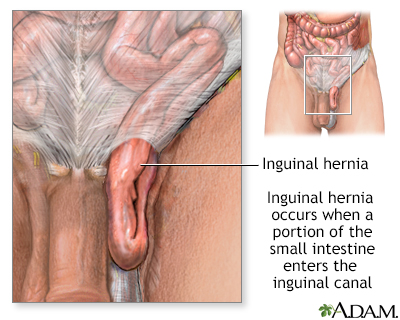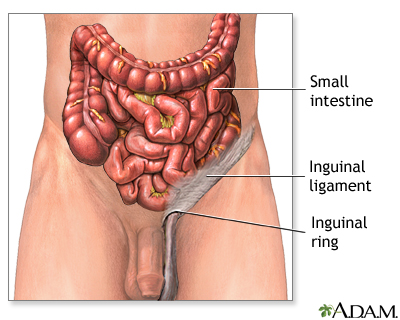Hernia
Hernia - inguinal; Inguinal hernia; Direct and indirect hernia; Rupture; Strangulation; Incarceration
A hernia is a sac formed by the lining of the abdominal cavity (peritoneum). The sac comes through a hole or weak area in the strong layer of the belly wall that surrounds the muscle. This layer is called the fascia.
Which type of hernia you have depends on where it is:
- Femoral hernia is a bulge in the upper thigh, just below the groin. This type is more common in women than men.
- Hiatal hernia occurs in the diaphragm muscle that separates the chest and abdomen. Part of the upper stomach pushes into the chest.
- Incisional hernia can occur through a scar if you have had abdominal surgery in the past.
- Umbilical hernia is a bulge around the belly button. Most often it occurs when the muscle around the belly button does not close completely after birth.
- Inguinal hernia is a bulge in the groin. It is more common in men. It may go all the way down into the scrotum.

Inguinal hernia is the result of an organ, usually bowel, protruding through a weak point or tear in the thin muscular abdominal wall. Inguinal hernias can restrict blood supply to the bowel herniated through the defect, creating a medical emergency.

A hernia occurs when part of an organ protrudes through a weak point or tear in the thin muscular wall that holds the abdominal organs in place.

Whenever your child is going in for surgery, it's a big deal for parents and for the child also. I'm Dr. Alan Greene and I'd like to discuss with you how to prepare your child, how to get ready for hernia surgery. The good news is that when the surgery is done you get instant results. Right away the problem's been fixed. And there are just a few steps to take to make the process go as smoothly as possible. Perhaps the first thing is preparing yourself because if you're feeling confident and good about the surgery, then everything will go much easier for you and for your child. And that means getting your questions answered beforehand. And in particular, the question I hear the most from parents is concern about the anesthesia. And that comes often from anesthesia risks that happened back when we were children. Anesthesia was much more dangerous than it is today. The problem was there weren't ways to monitor whether kids were getting enough oxygen to the brain or not. But since those monitors were developed about 20 years or so ago now, anesthesia has become incredibly safe - in fact, often safer than driving to the hospital. Now there other things that are important to do to prepare. First is to remember to take notice if your doctor has ordered any lab tests before the surgery. Perhaps blood tests, perhaps urine tests, maybe nothing was needed. But if it was, you want to make sure you've gotten it done before you end up going to the hospital. The second thing are instructions should've been given to you about when is the last time your child could eat or drink before heading to the hospital. Often it'll be midnight the night before, but whatever you were told be sure to take note of that and really don't cheat on this one. Nothing after what they say. And that leads to point number 3. Whatever medications that your child is taking, prescribed medicines, over-the-counter medicines, need to be taken into account. So, make sure you discuss with your physician, your anesthesiologist or the surgeon beforehand whatever medicines your child is taking and whether they should be taken or skipped after that deadline for food and drink. Next thing that's important, number 4, is to help your child select a favorite toy or stuffed animal, action figure to bring with them to the hospital. This little dog here or something that's comforting for them to have with them along the way. And it's a great idea before the whole thing depending on the age and temperament of your child to act out the whole scenario using their favorite toy. So, for instance, this little dog is not feeling well, hasn't been feeling well for awhile, has to take lots of medications, but the doctors are going to be able to fix it. Can't eat or drink anything after midnight - every step of it you go through. They're a little bit scared and they find out everything is fine and it worked out great and they get some ice cream afterwards and the problem is all gone. But to work it through with them so they get the story and it also helps you feel more prepared. I also suggest giving children something specific and fun to look forward to shortly after the surgery. It might be something as simple as a trip to the movies together or a trip to get ice cream but something that they can focus on. Take the focus a little bit off the surgery itself. Not a bad thing for you too. Then a couple of practical things. I do suggest that before going in you take off any jewelry that the child has, you bathe them, you get rid of even earrings that may stay in all the time or hair clips that may, you don't really want those at the hospital. And it's good to choose comfortable clothes when you go to the hospital, things that are easy on, easy off. It's not a fashion show. Although you may want some pictures of this cause it is a kind of historic moment. And lastly, if your child does develop any kind of fever or rash or cold beforehand, make sure to give them a call and let the folks know what's going on cause it may mean the surgery should be postponed. But the good news is that this kind of minor surgery today in children is extraordinarily safe and when it's done for the right child at the right time really helps move them ahead, move the family ahead. Most parents are really glad afterwards that the surgery has been done.
Causes
Usually, there is no clear cause of a hernia. Sometimes, hernias can occur due to:
- Heavy lifting
- Straining while using the toilet
- Any activity that raises the pressure inside the belly
Hernias may be present at birth, but the bulge may not be evident until later in life. Some people have a family history of hernias.
Babies and children can get hernias. It happens when there is weakness in the belly wall. Inguinal hernias are common in boys. Some children do not have symptoms until they are adults.
Any activity or medical problem that increases pressure on the tissue in the belly wall and muscles may lead to a hernia, including:
- Long-term (chronic) constipation and pushing hard (straining) to have a bowel movement
- Chronic coughing or sneezing
- Cystic fibrosis
- Enlarged prostate, straining to urinate
- Extra weight
- Fluid in the abdomen (ascites)
- Peritoneal dialysis
- Poor nutrition
- Smoking
- Overexertion
- Undescended testicles
Symptoms
There are usually no symptoms other than a visible bulge. Some people have discomfort or pain. The discomfort may be worse when standing, straining, or lifting heavy objects. In time, the most common complaint is a bump that is sore and growing.
When a hernia gets bigger, the small intestine inside it may get stuck in the hole and lose its blood supply. This is called strangulation. This causes pain and swelling at the site of strangulation. Symptoms may include:
- Nausea and vomiting
- Not being able to pass gas or have bowel movements
When this occurs, surgery is needed right away.
Exams and Tests
Your health care provider can usually see or feel a hernia when you are examined. You may be asked to cough, bend, push, or lift. The hernia may get bigger when you do this.
The hernia (bulge) may not be easily seen in infants and children, except when the child is crying or coughing.
An ultrasound or a CT scan may be done to look for a hernia.
If there is a blockage in the bowel, an x-ray of the abdomen will likely be done.
Treatment
Surgery is the only treatment that can permanently fix a hernia. Surgery may be more risky for people with serious medical problems.
Surgery repairs the weakened abdominal wall tissue (fascia) and closes any holes. Most hernias are closed with stitches and sometimes with mesh patches to plug the hole.
An umbilical hernia that does not heal on its own by the time a child is 5 years old will likely be repaired.
Outlook (Prognosis)
The outcome for most hernias is usually good with treatment. It is rare for a hernia to come back. Incisional hernias are more likely to return.
Possible Complications
In rare cases, inguinal hernia repair can damage structures involved in the function of a man's testicles.
Another risk of hernia surgery is nerve damage, which can lead to numbness in the groin area.
If a part of the bowel was trapped or strangulated before surgery, bowel perforation or dead bowel may result.
When to Contact a Medical Professional
Contact your provider right away if you have:
- A painful hernia and the contents cannot be pushed back into the abdomen by lying down and using gentle pressure
- Nausea, vomiting, or a fever along with a painful hernia
- A hernia that becomes red, purple, dark, or discolored
Contact your provider if you have:
- Groin pain, swelling, or a bulge.
- A bulge or swelling in the groin or belly button, or that is associated with a previous surgical cut.
Prevention
To prevent a hernia:
- Use proper lifting techniques.
- Lose weight if you are overweight.
- Relieve or avoid constipation by eating plenty of fiber, drinking lots of fluid, going to the bathroom as soon as you have the urge, and exercising regularly.
- Men should see their provider if they strain with urination. This may be a symptom of an enlarged prostate.
References
Poulose BK, Carbonell AM, Rosen MJ. Hernias. In: Townsend CM Jr, Beauchamp RD, Evers BM, Mattox KL, eds. Sabiston Textbook of Surgery. 21st ed. St Louis, MO: Elsevier; 2022:chap 45.
Salazar JH, Aiken JJ. Inguinal hernias. In: Kliegman RM, St. Geme JW, Blum NJ, et al, eds. Nelson Textbook of Pediatrics. 22nd ed. Philadelphia, PA: Elsevier; 2025:chap 394.
Version Info
Last reviewed on: 9/30/2024
Reviewed by: Jonas DeMuro, MD, Diplomate of the American Board of Surgery with added Qualifications in Surgical Critical Care, Assistant Professor of Surgery, Renaissance School of Medicine, Stony Brook, NY. Review provided by VeriMed Healthcare Network. Also reviewed by David C. Dugdale, MD, Medical Director, Brenda Conaway, Editorial Director, and the A.D.A.M. Editorial team.
